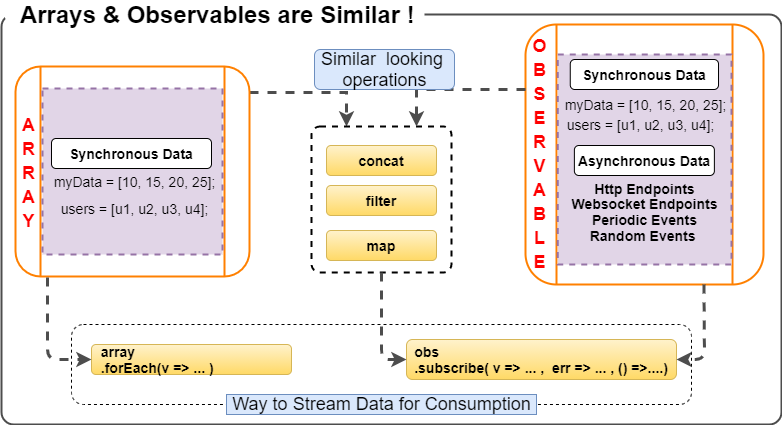Getting Started with RxJS
A Javascript or a Node based application invariably deals with lots of asynchronous data. Handling them without a proper library, can easily add a lot of complexities.
"The RxJS library provides one core type, the Observable, satellite types (Observer, Schedulers, Subjects) and operators inspired by Array methods (map, filter, reduce, every, etc) to allow handling asynchronous events as collections."
Access Anything as a Data Stream
As precisely mentioned in the excerpt above, RxJS library has been designed with the simplicity of an Array in mind. The library allows us to wrap both the synchronous data as well as the complex sources of asynchronous data the same way; so that consumer can access them as data streams from collections.

In fact, the power and huge popularity of this library across applications and frameworks is centered around the two core aspects :
1. Observables : Allows to access anything as simple collections
2. Operators : Provide declarative syntax to address our unique requirements
1. Observables
- Be it a synchronous data coming from a local array or a local variable
- Be it random events generated from button clicks, or
- Or be it some asynchronous data from a http or a series of data from a websocket end point
An observable allows us to wrap any data or source of data, and serve it as a data stream when a consumer subscribes the observable.
Access anything as simple collections
As we will see under Create Operators, we already have many operators like - of, from, range, ajax etc, which can create an Observable wrapping around our data or data point. Even we can easily create a new Observable from scratch for our custom data.
Let's look at some observable snippets, sourcing data from various types of data sources.
As we can see, with the observable in hand accessing data from an url, from click events, from a simple array or some custom data source, it's very similar!
- We need not have to bother about how does it access it's data or capture the error internally.
- All variations like -
callack,promise-then-catch,async-awaitwraped and exposed as observables.
- All variations like -
- Simply, subscribe to the observable, it will fetch us the data or a probable error.
- Now, we can simply focus on our incoming data or the probable error.
A lot more simplified task for us, is not it ?
Now let's move on to the other more interesting and intimidating part of the RxJs library.
2. Operators:
The number of operators RxJs provides is quite intimidating to look at, at it's first sight. But, once you understand their pourpose you would fall in love with them for sure!
It's because each one of them provide you with declarative syntax to address your unique requirements in your application development. These operators can help us avoid lot of custom implementations and save us lot of development and maintenance time.
The functional group summary categories them on a high level. We have discussed them in more details in their respective group and demo pages. Let's take up few use cases to understand their importance.
Declarative Syntax to Address our Unique Requirements
Let's say we want to run a set of 5 tasks - [T1, T2,...., T5]
-
concatMap : Run all tasks in Sequence, one after the other
of(T1,T2,T3,T4,T5).pipe(
concatMap(task => executeTask(task)),
).subscribe()
-
mergeMap : Run all in Parallel, for faster execution
of(T1,T2,T3,T4,T5).pipe(
mergeMap(task => executeTask(task)),
).subscribe()
-
exhaustMap : Run the earliest request and discard any concurrent duplicate requests
of(T1,T2,T3,T4,T5).pipe(
exhaustMap(task => executeTask(task)),
).subscribe()
-
switchMap : Run the latest request and cancel any older, obsolate ones
of(T1,T2,T3,T4,T5).pipe(
switchMap (task => executeTask(task)),
).subscribe()
-
forkJoin : Join multiple tasks and combine their end results
forkJoin(executeTask(T1),
executeTask(T2),
executeTask(T3),
).subscribe();
//Output : [T1-Output, T2-Output, T3-Output,]
These are just few examples showing the kind of choice these RxJS operators provide. We can implement multiple variations our custom requirements using a wide range of declarative syntaxes.